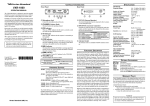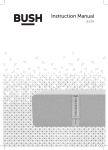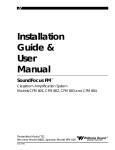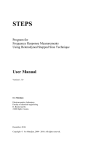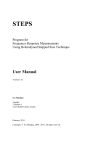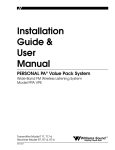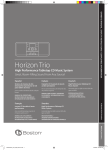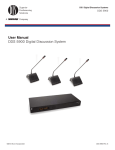Download Williams Sound R801 Installation guide
Transcript
Installation Guide & User Manual PERSONAL PA® FM Monitor Receiver Model R801 R801 Professional FM Auditory Assistance Receiver Williams Sound Frequency Synthesized, Channel-Selectable Power Frequency 72.5 72.7 72.3 Carrier 72.9 72.1 74.7 75.9 75.3 75.7 75.5 Squelch Phones For use with Transmitter Models: PPA T4, PPA T17, PPA T20, PPA T16, PFM T30, PFM T31 MAN 098B ® Williams Sound Helping People Hear PERSONAL PA® FM MONITOR RECEIVER MODEL R801 INSTALLATION AND USER MANUAL Contents Page System Overview 3 System Components 3 Quick Start Instructions 4 R801 Receiver Features 5 Optional Antennas 6 Setting the Squelch Control 7 Changing Frequencies 7 Using Multiple Systems 8 In Case Of Difficulty 8 Optional Rack Mounting Kits 9 Warranty 9 Receiver Specifications 10 2 Williams Sound ® Helping People Hear SYSTEM OVERVIEW Thank you for purchasing the PERSONAL PA® FM Monitor Receiver from Williams Sound Corp. This monitor receiver is intended to be used for hearing assistance with a Williams Sound PERSONAL PA Transmitter operating on one of 10 wideband channels from 72 - 76 MHz. The Monitor Receiver provides a convenient way to receive the PPA Transmitter broadcast in a remote location. Depending the antennas being used, the receiver will operate up to 500 feet from the transmitter To avoid difficulties, please read through these instructions as you begin to use the system. Then save them for questions that arise as you continue to use your Williams Sound Monitor Receiver. If you have problems with the system, don’t hesitate to call us toll-free at 1-800-843-3544. SYSTEM COMPONENTS (R801) • FM Receiver (R801) • Power Supply (TFP 016) • “Rubber Duck” Antenna (ANT 021) • 1m RCA to RCA Audio Cable with RCA to 1/4” Adapter (WCA 013/CNA 007) • Instruction Manual (MAN 098) FIG. 1: OVERALL SYSTEM DIAGRAM R801 Professional FM Auditory Assistance Receiver PPA T4 Professional FM Auditory Assistance Transmitter Phones Audio Adjust Power Power Audio Level -12dB -6dB 0dB +6dB Decrease Williams Sound Frequency Synthesized, Channel-Selectable Frequency Synthesized, Channel-Selectable RF Carrier Frequency 72.5 72.7 72.3 74.7 75.9 Increase Lo Ok Ok Too Hi PPA Transmitter Carrier 72.9 72.1 75.3 75.7 75.5 Squelch Phones R801 Receiver Amplifier Speakers HOW IT WORKS: The PPA Transmitter produces the FM radio signal. The R801 picks up the transmitterd signal and feeds it into a sound system. Williams Sound ® Helping People Hear 3 QUICK START INSTRUCTIONS 1. Make sure the R801 Receiver is set to the same operating frequency as your transmitter. See the transmitter instructions for frequency identification. Alternately, see step 6 below. 2. Choose a location for the R801 Receiver. Take into account proximity to the sound system, availability of AC power, rack mounting,and antenna installation requirements. 3. Install the Antenna. The rubber duck antenna threads into the hole on top of the receiver. Remote antennas connect to the “F” type connector on the rear of the R801. See page 6 for remote antenna installation details. 4. Plug the Power Supply connector into the R801. The locking tab on the connector should point UP as shown on the R801 rear panel. Plug the power supply into an AC outlet. 5. Connect the R801 Receiver to the audio input of your sound system, using the audio cable provided. The cable provided is for an unbalanced connection. If you wish to use a balanced connection, you will need to supply your own TRS cable. 6. Turn the R801 Power switch ON. Change the R801 Channel Selector until the Carrier light turns on and you hear the transmitter signal in the headphone jack. 7. Adjust the squelch control. See page 7 for details. 8. Set the volume on your sound system. 4 Williams Sound ® Helping People Hear R801 MONITOR RECEIVER FEATURES R801 FRONT PANEL FEATURES R801 Professional FM Auditory Assistance Receiver Williams Sound Frequency Synthesized, Channel-Selectable Power Frequency 72.5 72.7 72.3 Carrier 72.9 72.1 74.7 75.9 75.3 75.7 75.5 Phones Squelch POWER ON/OFF SWITCH Turns R801 power on or off. POWER LED INDICATOR Glows when the R801 power is on. FM FREQUENCY SWITCH The selected receiver channel must match the transmitter channel. The system is pre-set to 72.9 MHz. Change the receiver channel only if the transmitter channel has been changed. See your Transmitter instructions to change the transmitter channel. FM CARRIER LED INDICATOR Glows when a carrier frequency is present. PHONES JACK Allows monitoring the audio signal with mono or stereo headphones. (1/4” TRS) SQUELCH ADJUST Sets Receiver incoming signal mute level. R801 REAR PANEL FEATURES Balanced or Unbalanced Line Out Professional FM Auditory Assistance Receiver Williams Sound Corp., Minneapolis, MN USA Antenna Power In Plug 24 VAC 50-60 Hz 75 Ohms LINEOUTPUT This 1/4” TRS jack provides a balanced or unbalanced line-level audio output. Connect the Tip or Ring to the Sleeve for an unbalanced signal. Connect to Tip (+) Ring (-) and Sleeve (Com) for a balanced signal. REMOTE ANTENNA CONNECTOR “F–type” connector for 75Ω Remote Antennas (ANT 005, ANT 024) AC POWER SUPPLY Molex-type connector for TFP 016 Power Supply. FLEXIBLE “RUBBER DUCKIE” ANTENNA Threads onto the mounting stud on top of the receiver. ANT 025 may also be used. Williams Sound ® Helping People Hear 5 USING AN ALTERNATE ANTENNA The operating range of the system is dependent on which antenna is used on the Receiver AND which antenna is used on the base-station Transmitter. The standard ANT 016 Rubber Duckie Antenna on both Receiver and Transmitter will provide sufficient operating range (up to 300 ft) for most applications. Three optional antennas are also available which will extend the operating range and offer some installation alternatives: ANT 005 Coaxial Antenna When used on the Transmitter and the Receiver, this optional 80” dipole wall mount antenna provides the greatest range (up to 500 ft.). ANT 024 Dipole Antenna This optional antenna provides nearly the operating range of the ANT 005 Coax Antenna, but is easier to install and is shorter. ANT 025 Whip This 40” whip antenna threads onto the mounting stud on top of the receiver or Transmitter. It provides improved range (350 - 400 ft.) compared to the standard ANT 016 antenna. ANT 005 ANT 024 REMOTE ANTENNA LOCATION TIPS þ Install the ANT 005 or ANT 024 with its elements vertical. The antenna is best installed on a wall 10 to 15 feet above the floor. It may be located in the next room from the listening area if the separating wall does not contain metal lath, steel studs, foil-backed insulation, or significant ductwork. Do not install the antenna in an organ chamber. The numerous pipes of an organ significantly deflect and absorb the radio signal. þ The ANT 005 and ANT 024 feedline is classified under the National Electrical Code as Class II wiring and may be installed in conduit with other Class II wiring. It SHOULD NOT be installed with Class I (power) wiring. þ Do not connect the coaxial cable to the building or electrical ground in any way. AVOIDING UNDESIRABLE ANTENNA INSTALLATIONS Transmission (range, directional properties) can be severely impaired by improper installation of the antenna. 6 þ DO NOT install the antenna within any metal enclosure. þ DO NOT install the antenna where it is separated from the listening area by any substantial metal object, such as heating ducts, structural steel, foil backed insulation, steel studs or metal lath. Williams Sound ® Helping People Hear SETTING THE SQUELCH CONTROL The squelch control sets the incoming signal level required to un-mute the R801. If the receiver is not locked onto a signal, it can produce noise. The function of the squelch circuit is prevent this noise when no signal is present., When the squelch is properly adjusted, turning off the Transmitter will cause the R801 to mute. The radio noise in each area is different, so you must adjust the squelch when the R801 is installed. 1. Make sure the R801 is plugged in, turned on, and has an antenna attached. 2. Make sure the Transmitter is OFF. 3. Use headphones to listen to the R801 Phones Jack. 4. Set the R801 Frequency Selector to the desired channel. 5. While listening to the headphones with the Transmitter still OFF, turn the Squelch control counter-clockwise until noise is heard in the headphones. 6. Slowly turn the Squelch control clockwise just until the noise disappears. 7. Turn the Transmitter ON. The signal in the headphones should be clear and free from noise and interference, unless you are out of range of the Transmitter. 8. Turn the Transmitter OFF. The R801 should immediately go silent. Re-adjust the squelch control if necessary. CHANGING FREQUENCIES/IF YOU EXPERIENCE INTERFERENCE If you experience FM signal interference, you can easily adjust your transmitter and receiver to a use different frequencies. The Transmitter and Receiver Frequencies must always match. CHECKING FOR A CLEAR CHANNEL: The R801 can be used to “scan” for a clear channel in your area. With the Transmitter turned OFF, Move the Frequency Selector switch on the front panel of the R801 and observe the Carrier indicator light, while listening with headphones plugged into the PHONES jack. If it comes on, that indicates another transmitter is operating on that channel in your area. You should select another channel to use. CHANGING THE R801 RECEIVER FREQUENCY: 1. Simply select an alternate channel with the Frequency Selector switch on the front panel. The selector knob shows which frequency you have selected. 2. Make sure the Transmitter matches the Receiver channel. See your Transmitter intructions. Williams Sound ® Helping People Hear 7 USING MULTIPLE CHANNELS: 1. Multi-channel systems require a Transmitter and a Receiver for each channel. 2. Make sure each Transmitter matches each Receiver channel. See your Transmitter intructions. 3. You may be able to use adjacent channels in multi-channel systems if the R801 is the only receiver used. Other PPA Receivers cannot use adjacent channels. 4. You may use more than one receiver with each Transmitter. 5. To avoid interference, DO NOT operate two transmitters on the same channel in the same room. IN CASE OF DIFFICULTY IF NO SOUND IS PRODUCED 1. Make sure the Transmitter and Receiver are ON and operating on the same channel. If the Transmitter has a Phones jack, listen to make sure the Transmitter has a signal. 2. Make sure the receiver carrier light is ON. If it is not, there is either no transmitter signal, the receiver is set to the wrong channel, the receiver is out of range for the transmitter, or there is a fault with the receiver. 3. Make sure the antenna is installed properly. If the receiver is out of range, the ANT 005 or ANT 026 remote antenna may be needed. Try moving the transmitter and receiver closer together. 4. The squelch control may not be set properly. Try turning the control counter-clockwise to see if the Carrier light comes on and the signal comes through. 5. Listen to the signal at the headphone jack on the R801. If there is no signal, there is either no Transmitter signal or there is a fault with the R801. If there is a good signal at the headphone jack, but not through your sound system, check the cable and audio connection between the R801 and the sound system. IF INTERFERENCE OCCURS 1. Do not try to use more than one transmitter on the same channel in close proximity to each other. Use separate channels for each Transmitter used. 2. If you are still hearing interference on the receiver, turn the transmitter off and listen with a receiver. If you hear the interference with the transmitter off, you need to change to a clear channel. See the frequency change instructions on page 7. IF PROBLEMS REMAIN If none of the remedies above provides the solution, call Williams Sound’s Customer Service Department at 1-800-843-3544 (8:00 AM– 4:30 PM Central Time). 8 Williams Sound ® Helping People Hear OPTIONAL MOUNTING KITS Williams Sound offers two optional rack mounting kits for use with the R801 FM Monitor Receiver. Use the RPK 005 Kit to mount one R801 in a single rack space. Use The RPK 006 Kit to mount two R801’s in a single rack space. NOTE: If you are rack mounting the R801, you will likely need a remote antenna. The antenna cannot be inside a metal enclosure. To order these optional components, contact your dealer or Williams Sound Corp. RPK 005 RPK 006 WARRANTY The Williams Sound R801 FM Monitor Receiver is engineered and designed to provide you with many years of reliable service. Williams Sound warrants it against defects in materials and workmanship for FIVE (5) years EXCEPT FOR cables, antennas, and all other accessory products. Accessory products carry a 90 day warranty. If the product fails within the specified warranty period, Williams Sound will determine whether to repair or replace the defective equipment. This warranty does not apply to physical damage, abuse, mis-use, or products that have been modified. If you experience difficulty with your system, call for Customer Assistance: 1-800-328-6190. If it is necessary to return the system for service, a Williams Sound representative will give you a Return Authorization Number (RA) and shipping instructions. Pack the system carefully and send it to: Williams Sound Corp. 10399 West 70th Street Eden Prairie, MN 55344-3459 USA Phone: Fax: TTY: e-mail: 800-843-3544 / 612-943-2252 952-943-2174 952-943-9675 [email protected] Your warranty becomes effective the date you purchase your system. Your returned warranty card is our way of knowing when your warranty begins. It also gives us important information about your system including the serial number. This information will help us serve you better in the future. Please take a moment to complete and mail the attached card. Thank you. Williams Sound ® Helping People Hear 9 PERSONAL PA® FM MONITOR RECEIVER SPECIFICATIONS MODEL R801 Dimensions, Weight: 1.75" H x 8.45" W x 8.25" D, 3lbs. Color: Black epoxy paint with white legends Rack Mount: One EIA rack space high, 1/2 space wide, 1-2 units can be mounted in a single rack space with optional RPK 005 (single) or RPK 006 (double) Rack Mount kits. Power: 24VAC, 50/60Hz, TFP 016 supplied, Molex connector Power Indicator: Green LED, Front panel Operating Freq.: 10 Channel Selectable (72.1, 72.3, 72.5, 72.7, 72.9, 74.7, 75.3, 75.5, 75.7, 75.9 MHz*) Freq. Accuracy: 0.01%, Frequency Synthesized, Crystal Reference FM Deviation: +/- 75kHz, 75µS de-emphasis Sensitivity: 0.8µV at 12 dB Sinad with squelch at minimum Carrier Indicator: Green LED, Front panel Freq. Response: 50 to 18kHz, +1, -4 dB Signal/Noise Ratio: 60 dB at 100µV. Receiver Antenna: Flexible “rubber duckie” type or optional 75 Ohm remote antenna Controls: Power On/Off, FM Channel, Squelch. Distortion: less than 1.0% at rated power Phones Output: 1/4” TRS, 10mVrms @ 50 Ohms impedance. Line Output: 1/4” TRS, Balanced (Tip is positive, Ring is negative, Sleeve is common) or Unbalanced (Tip or Ring can be connected to the Sleeve), nominal output: +4dBm @ 600 Ohms, 1.2Vrms Additional Notice: This device complies with the requirements of Industry Canada (IC), as specified in document RSS-210. The device is permitted only on a no-interference no-protection basis, that is, it must cease operation when it is determined (such as by turning the device on and off) that it causes harmful interference to services authorized by IC. Authorized services are listed in the Canadian Table of Frequency Allocations or as determined by IC from time to time. Also, the operator must accept any radio interference received, including interference that may cause undesired operation of the device. Williams Sound Corp. 10399 West 70th St., Eden Prairie, MN 55344-3459 U.S.A. 800-328-6190 / 952-943-2252 / FAX: 952-943-2174 www.williamssound.com 10 © 2000, Williams Sound Corp. MAN 098 B Williams Sound ® Helping People Hear










